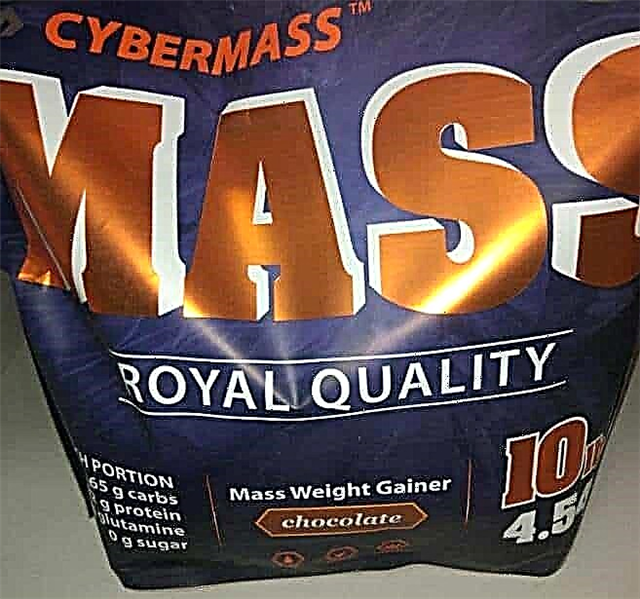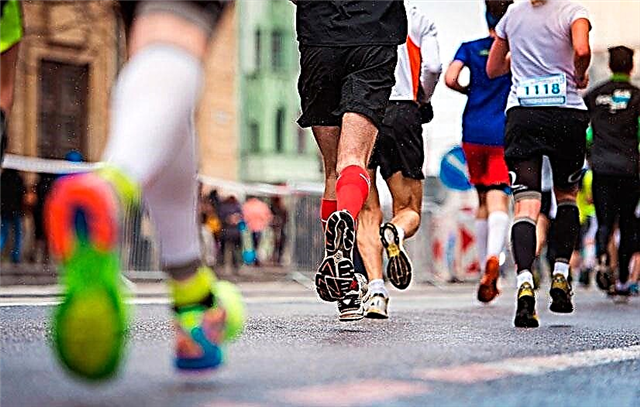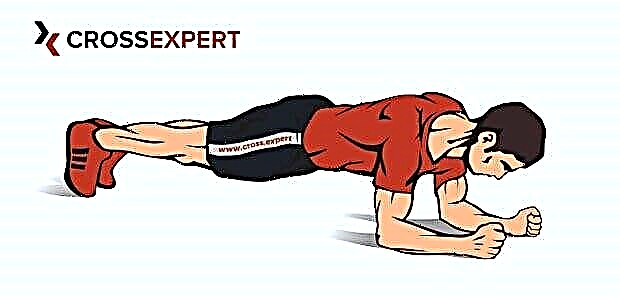In many athletes, the arms are noticeably lagging behind large muscle groups in development. There may be several reasons: excessive enthusiasm for only basic exercises or, conversely, too much isolating work on the hands, which already work in all presses and deadlifts.
If you want to build biceps and triceps, you need to correctly combine the base and special exercises for the arms. From the article you will learn about the features of such exercises and the correct technique for their implementation, and we will also offer several training programs.
A little about the anatomy of the arm muscles
Before we look at exercises for developing hands, let's turn to anatomy. This is necessary to understand the specifics of the muscle group in question.
The arms are a massive volume of musculature distributed over many small muscle groups. It will not be possible to work through them all at the same time due to the structural features. The muscles of the arms are mostly opposed to each other, which requires a differentiated approach to exercises:
| Muscle | Opposed muscle |
| Biceps flexor muscle (biceps) | Triceps extensor muscle (triceps) |
| Flexor muscles of the wrist | Extensor muscles of the wrist |

© mikiradic - stock.adobe.com
As a rule, when it comes to training the arms, they mean biceps and triceps. The muscles of the forearm are trained separately or not at all - usually they already develop harmoniously with the arms.
Training recommendations
Due to the small size of the muscles and the possibility of cheating in the exercises, there are the following training recommendations:
- Work one muscle group of the arms per workout. For example, back + biceps or chest + triceps (principle of training synergistic muscles). This optimizes the workflow and allows you to combine heavy basic movements with special ones. Experienced athletes can specialize their arms, pumping them completely in one day. This approach is not recommended for beginners.
- If you are doing biceps after the back or triceps after the chest, a couple of exercises will be enough for them. If you do 4-5, it will lead to overtraining, your arms will not grow. The same can happen if your split is built like this: back + triceps, chest + biceps. In this case, the biceps will work 2 times a week, and the triceps will work at all 3 (one more time a day for the shoulders with the press). It's too much.
- Work in a multi-rep style - 10-15 reps. This reduces the risk of injury and increases the blood filling of the muscles. Small muscles respond better to this load, since they were not originally designed to lift large weights.
- Exercise rigorously. Leave cheating to professional athletes. It will be much more effective to lift a 25 kg barbell to the biceps absolutely cleanly than to throw 35 kg with the body and shoulders.
- Do not get carried away with pumping, supersets and drop sets. In the example above, again, it will be more effective to lift a barbell of 25 kg for biceps 12 times than doing 15 kg by 20 or 15-10-5 kg by 10 (drop set). These techniques are best used when reaching a certain plateau in the set of mass, already having experience in strength training and decent working weights.
Exercises for arm muscles
Biceps
The biceps is the target muscle group for many athletes. Let's take a look at typical biceps exercises. Form an individual complex based on our proposed movements.
Standing barbell raises
The most common exercise for this muscle group. Despite the fact that many consider it basic, it is insulating - only the elbow joint works. However, it is quite effective if done correctly:
- Take the shell in your hands. You can use any neck - straight or curved, it all depends on your preference. Many people experience wrist discomfort when lifting with a straight bar.
- Stand straight with feet shoulder-width apart.
- As you exhale, bend your arms at the elbow due to the efforts of the biceps, trying not to move your back and not bring your arms forward. Do not use momentum when tossing the barbell up with the body.
- In the upper phase of the amplitude, linger for 1-2 seconds. At the same time, strain your biceps as much as possible.
- Slowly lower the projectile, not fully extending your arms. Start the next repetition immediately.

© Makatserchyk - stock.adobe.com
Why can't you fully extend your arms? It's all about the articular resistance, which must be overcome when lifting again. By lowering your arms completely, you are not training muscles, but ligaments and tendons. Another reason is that the biceps will rest at this point. It is better when he is under load all the time.
Standing and Seated Dumbbell Raises
The advantage of dumbbells over the barbell is that you can work your arms separately, concentrating more on each of them. Such lifts can be performed while standing (it will turn out to be almost an analogue of the previous exercise) and sitting, and on an incline bench. The latter option is the most effective, since the biceps are in tension even when the arms are lowered.
Execution technique:
- Place the bench at a 45-60 degree angle.
- Take dumbbells and sit down. The grip is supinated, that is, the palms initially look from the body and their position does not change.
- As you exhale, bend your arms at the same time, while fixing your elbows and do not pull them forward.
- Hold the peak contraction for 1-2 seconds.
- Lower the shells under control without bending your arms to the end.

© Makatserchyk - stock.adobe.com
Alternatively, you can take turns doing this exercise with your left and right hands. A variant with a neutral grip in the starting position and supination of the hand during lifting is also admissible.

© Makatserchyk - stock.adobe.com
Scott Bench Rises
The advantage of this exercise is that you cannot cheat. You rest tightly against the simulator with your chest and triceps, and during lifting you should not take your hands off it. Thanks to this design, only the biceps work here. In order to exclude the help of the muscles of the forearm, take an open grip (the thumb is not opposed to the rest) and do not bend / unbend the wrists.
The movement can be performed with both a barbell and a dumbbell. Choose the most convenient option for yourself, or simply alternate them from workout to workout.

© Makatserchyk - stock.adobe.com

© Makatserchyk - stock.adobe.com
Narrow Reverse Grip Pull-ups
The only basic exercise for biceps - two joints (elbow and shoulder) work here, and the back muscles are also actively involved. It is quite difficult for many to learn to pull up only with the hands, therefore this exercise is rarely found in complexes. Fortunately, isolation and indirect participation in the basic deadlifts when training the back is sufficient for the biceps to successfully work out.
To use the muscle group we need as much as possible, perform pull-ups as follows:
- Hang on the bar with a narrow back grip. Since the hands are supinated, the biceps will be heavily loaded. You do not need to use the straps. The wider the grip, the more emphasis is placed on the lats.
- Pull yourself up by bending your elbows. Try to concentrate on this particular movement. The chin should be above the bar.
- Hold this position for 1-2 seconds, straining your biceps as much as possible.
- Slowly lower yourself down.

Lifting the bar while lying on an incline bench
Another great biceps exercise. Cheating is also excluded here, since the body is fixed on the bench (it must be installed at an angle of 30-45 degrees and lie down on the chest). The only thing that remains to be watched is the elbows, which do not need to be brought forward when lifting.
The rest of the technique is similar to conventional barbell curls for the biceps. However, the working weight will be less here.

© Makatserchyk - stock.adobe.com
Concentrated dumbbell curls
A good exercise is usually done with light weight, since large dumbbells require strong enough arms and biceps. It is better to take less weight, but do the movement clearly and without the slightest cheating - then the load will go exactly to the muscle group we need.
The technique is as follows:
- Sit on a bench, spread your legs apart so that they do not interfere with the rise.
- Take a dumbbell in your left hand, rest your elbow on the thigh of the same name. Place your other hand on your right leg for stability.
- Bend the arm with the effort of the biceps arm. Record the peak contraction.
- Lower it down under control, without unbending it to the end.

© Makatserchyk - stock.adobe.com
Crossover upper arm curls
Many athletes like this exercise, since the arms are in an atypical position for pumping biceps - raised to parallel with the floor. This allows you to load the muscles from a slightly different angle and diversify the training. It is best to place these curls at the end of the workout.
The technique is as follows:
- Grab both upper crossover grips - left to left, right to right. Stand between the racks of the simulator with your side to them.
- Raise your arms so that they are perpendicular to your body and parallel to the floor.
- Bend your arms at the same time, while fixing the position of the elbows and not lifting them.
- At the peak point, squeeze your biceps as much as possible for 1-2 seconds.
- Extend your arms slowly (not fully) and immediately begin the next repetition.

© Makatserchyk - stock.adobe.com
Rises on the lower block or in the crossover
Lower block curls or lower crossover handle curls are a good option to complete your bicep workout. As a rule, this exercise is performed in a fairly high number of repetitions - 12-15 and its main purpose is to "finish off" the muscle and how to fill it with blood.
The technique is simple and similar to a normal barbell lift, except that a special handle is used instead of a bar. You need to stand not close to the block, but slightly move away from it, so that in the lower position the biceps is under load.
The movement can be performed with two hands with a straight handle:

© antondotsenko - stock.adobe.com
Or do it in turn with one hand:

© Makatserchyk - stock.adobe.com
When using a rope, the main emphasis of the load is shifted to the shoulder and brachioradial muscles (as in the hammer exercise, which will be discussed below):

© Jale Ibrak - stock.adobe.com
"Hammers"
To increase the volume of the arms, you need to remember to pump the brachialis muscle (brachialis) located under the biceps. With hypertrophy, it kind of pushes the biceps muscle of the shoulder, which leads to an actual increase in the girth of the arms.

The most effective exercises for this muscle are lifting the bar and dumbbells for the biceps with neutral (palms facing each other) and reverse grip (palms facing back).
“Hammers” is an exercise performed this way with a neutral grip. Most often it is done with dumbbells - the technique completely copies the usual dumbbell lifts, only the grip differs. You can perform it both standing and sitting.

© Makatserchyk - stock.adobe.com
Also, "hammers" can be performed with a special neck, which has parallel handles:

© Makatserchyk - stock.adobe.com
Reverse grip barbell lifts
Another exercise for the shoulder and brachioradial muscles. Identical to straight grip lifts, only slightly less weight.

Triceps
As a rule, athletes have no triceps problems due to the bench press craze. However, other exercises are also needed.
Bench press with a narrow grip
Basic triceps exercise. To a lesser extent, the chest and front deltas are involved.
Execution technique:
- Sit on a straight bench. Place your whole foot firmly on the floor. There is no need to make a “bridge”.
- Grasp the bar with a closed grip slightly narrower or shoulder-width apart. The distance between the hands should be approximately 20-30 cm.
- While inhaling, slowly lower the barbell to your chest, while not spreading your elbows to the sides, they should go as close to the body as possible. If you feel discomfort in the wrists when lowering, increase the width of the grip, try to lower it not to the chest, leaving 5-10 cm, or try using wrist wraps.
- As you exhale, with a quick movement, squeeze the barbell, straightening your arm to the end at the elbow joint.
- Do the next repetition.

© Makatserchyk - stock.adobe.com
The bench press can also be performed with dumbbells - in this case, they need to be taken with a neutral grip and, when lowering, the elbows should be led along the body in the same way:

© Makatserchyk - stock.adobe.com
French press
One of the best exercises for this muscle group, although it is isolating.
The only but tangible disadvantage is that the French bench press with a barbell is almost guaranteed to “kill” the elbows with large working weights (about over 50 kg). That is why either do it at the end of the workout, when the triceps are already hammered and a lot of weight is not needed, or replace it with the option with dumbbells, or do it while sitting.
In the classic embodiment - lying with a barbell and lowering behind the head - the long triceps head is most loaded. If lowered to the forehead, the medial and lateral work.
Execution technique:
- Take a barbell (you can use both a straight and curved bar - as it will be more comfortable for your wrists) and lie on a straight bench, rest your feet firmly on the floor, you do not need to put them on the bench.
- Straighten your arms with the bar above your chest. Then take them, without bending, towards the head to about 45 degrees. This is the starting position.
- Slowly lower the shell behind your head, bending your arms. Lock your elbows in one position and do not spread them apart. At the lowest point, the angle at the elbow joint should be 90 degrees.
- Extending your arms, return to the starting position. The movement occurs only in the elbow joint, the shoulders do not need to be moved in any way.
- Do the next repetition.

To reduce the stress on your elbows, you can do the same exercise with dumbbells:

© Makatserchyk - stock.adobe.com
Another good option is sitting. Here the technique is similar, only the arms do not need to be pulled back, perform flexion and extension from the vertical starting position of the arms.

© Makatserchyk - stock.adobe.com
Triceps Dips
Regular dips work your chest muscles to a greater extent. However, you can shift the focus to triceps by slightly changing your technique:
- The starting position is an emphasis on the uneven bars on straight arms. The body should be located strictly perpendicular to the floor (and when lowering / lifting too), you do not need to lean forward. If you can change the distance between the bars, for the triceps version of the push-up it is better to make it slightly smaller. At the same time, you can bend your legs if it is more convenient for you.
- Slowly lower yourself down, bending your arms. At the same time, take your elbows not to the sides, but back. The amplitude is as comfortable as possible, but not more than a right angle at the elbow joint.
- Extending your arms, rise to the starting position. Straighten your arms all the way and start a new repetition.

© Yakov - stock.adobe.com
If you find it difficult to perform the required number of repetitions (10-15), you can use the gravitron - this is a simulator that facilitates push-ups on the uneven bars and pull-ups due to a counterweight:

© Makatserchyk - stock.adobe.com
Back to bench push-ups
Another basic exercise for the triceps brachii. Like almost the entire triceps base, it actively involves the muscles of the chest and the front bundle of deltas.
Execution technique:
- Place two benches parallel to each other. Sit on one of them on the edge, rest your hands on both sides of the body, and on the other, put your legs so that the emphasis falls on the ankle.
- Rest your hands and hang your pelvis off the bench. The angle between the body and the legs should be approximately 90 degrees. Keep your back straight.
- As you inhale, bend your arms to a comfortable angle without bending your legs. It is not necessary to go down too low - there is an excessive load on the shoulder joint. Take your elbows back, do not spread them to the sides.
- As you exhale, rise to the starting position by extending the elbow joint.
- If it's too easy for you, put the barbell pancakes on your hips.

© Makatserchyk - stock.adobe.com
In some gyms, you can find a simulator that imitates this type of push-up:

© Makatserchyk - stock.adobe.com
Push-ups from the floor with a narrow stance
Classic push-ups can also be done to work out the triceps.To do this, you need to stand at close range lying so that your hands are close. At the same time, turn them towards each other so that the fingers of one hand can cover the fingers of the other.
When lowering and lifting, watch your elbows - they should go along the body.

© Makatserchyk - stock.adobe.com
Kick-back
This is an extension of the arm with a dumbbell along the body in an incline. Due to the position of the torso and the arm fixed in one position, the weight will be small here, but the entire load, if done correctly, will go into the triceps.
The classic version of the execution implies support on a bench, as when pulling a dumbbell to the belt:

© DGM Photo - stock.adobe.com
You can also do it while standing in an inclination, simply leaning on the second leg, put forward:

© Makatserchyk - stock.adobe.com
Another option is from the lower crossover handles:

Finally, kickbacks can be performed with two hands at once. To do this, you need to lie with your chest on a slightly raised or straight bench:

Extension of arms with dumbbells from behind the head
This exercise can be called a type of French bench press, but it is very common in gyms, therefore, it is taken out separately. The emphasis here is on the long head of the triceps. It is recommended that you insert one of the sitting or standing extensions into your workout plan with your arm raised.
Technique for performing with one dumbbell with two hands:
- Sit on a straight bench or a bench with a low vertical back (a high back can get in the way when lowering the dumbbell). Don't bend your lower back.
- Take a dumbbell in your hands, raise it above your head, straightening your arms so that they are perpendicular to the floor. In this case, it is most convenient to hold the projectile under the upper pancake.
- As you inhale, slowly lower the dumbbell behind your head, while being careful not to touch it. The amplitude is the most convenient for you, but you need to reach an angle of 90 degrees.
- As you exhale, extend your arms to their original position. Try not to spread your elbows to the sides.

© Nicholas Piccillo - stock.adobe.com
You can work with one hand in the same way. At the same time, it is advisable to hold the second elbow of the working hand so that it does not go to the side.

© bertys30 - stock.adobe.com
Extension of arms on the block
A classic example of a triceps finishing exercise. It is most often done at the end of a workout to maximize blood flow to the target muscle. Another use case is at the beginning of a class to warm up.
The main thing when doing it is to strictly fix the body and elbows so that the movement occurs only due to the flexion and extension of the arms. If your elbows go forward, take less weight.
The exercise can be done with a straight handle:

© blackday - stock.adobe.com
A variant with a rope handle is often found:

© Jale Ibrak - stock.adobe.com
Another interesting variation is one-handed reverse grip:

© zamuruev - stock.adobe.com
Try all the options, you can alternate them from workout to workout.
Extension with a rope from the lower block
Another exercise for the long head of the triceps. Performed on the lower block or in the crossover:
- Hook the rope handle onto the device.
- Take it and stand with your back to the block, while lifting the rope so that it is at the back at the level of your back, and your arms are raised up and bent at the elbows.
- As you exhale, straighten your arms, as when doing dumbbell extensions from behind your head. Try not to spread your elbows to the sides.
- As you inhale, bend your arms again and begin a new repetition.

© Alen Ajan - stock.adobe.com
Extension with a rope forward from the upper block
In this case, the rope handle must be attached to the upper handles of the crossover or block trainer. Then grab it and turn your back, similar to the previous exercise. Only now the handle will be higher than your head, since it is not attached to the lower rack. Take a step or two forward to lift the weight on the simulator, rest your legs firmly on the floor (you can do this in a half-lunge position) and extend your arms from behind your head until you are fully extended.

© tankist276 - stock.adobe.com
Forearms
The forearms are active in basic exercises and in many isolating exercises for the biceps and triceps. Separately, it makes sense to work them out with a noticeable lag or if you have some other goals, for example, when performing in arm wrestling.
In the general case (not for specific armwrestling training), two exercises will be enough:
- Heavy weight retention.
- Flexion / extension of the hands in support.
In the case of holding a heavy weight, the following exercise technique can be used:
- Pick up heavy dumbbells or kettlebells without using a safety belt.
- Then you can just keep them for the maximum amount of time or walk, as when doing a farmer's walk.
- Another option is to slowly unclench your fingers while continuing to hold the dumbbells at the tips, and then quickly squeeze. And repeat this several times.
- You can complicate the exercise by wrapping a towel around the handles of the shells. The wider the handle, the more difficult it is to hold it.

© kltobias - stock.adobe.com
Flexion and extension of the hands in the support are performed as follows:
- Sit on the bench, take the bar and put your hands with it on the edge of the bench so that the hands with the projectile hang down. At the same time, the palms look at the floor.
- Next, lower the brushes down to the maximum depth and raise them up. Repeat 15-20 times.
- Then you need to do a similar exercise, but with palms facing off the floor.

© Makatserchyk - stock.adobe.com
Remember that the muscles of the forearms work well in almost all exercises. If you are not engaged in special disciplines or have not rested on a strength plateau, there is no need to develop them separately.
Hand development programs
In general, for the harmonious development of the arms, it would be ideal to use the classic split: chest + triceps, back + biceps, legs + shoulders.
| Monday (chest + triceps) | |
| Bench press | 4x12,10,8,6 |
| Incline Dumbbell Press | 3x10 |
| Dips on the uneven bars | 3x10-15 |
| Layout lying on an incline bench | 3x12 |
| Bench press with a narrow grip | 4x10 |
| French bench press | 4x12-15 |
| Wednesday (back + biceps) | |
| Wide grip pull-ups | 4x10-15 |
| Bent-over barbell row | 4x10 |
| Narrow Reverse Grip Row | 3x10 |
| Row of one dumbbell to the belt | 3x10 |
| Standing barbell curls | 4x10-12 |
| Hammers sitting on an incline bench | 4x10 |
| Friday (legs + shoulders) | |
| Barbell Shoulder Squats | 4x12,10,8,6 |
| Leg press in the simulator | 4x10-12 |
| Romanian barbell deadlift | 4x10-12 |
| Standing Calf Raises | 4x12-15 |
| Seated Dumbbell Press | 4x10-12 |
| Wide grip barbell pull | 4x12-15 |
| Swing to the sides in the slope | 4x12-15 |
Experienced athletes can specialize in biceps and triceps for 2-3 months:
| Monday (hands) | |
| Bench press with a narrow grip | 4x10 |
| Standing barbell curls | 4x10-12 |
| Triceps Dips | 3x10-15 |
| Dumbbell curls sitting on an incline bench | 3x10 |
| Seated French press | 3x12 |
| Concentrated flexion | 3x10-12 |
| Extension of arms on a block with a straight handle | 3x12-15 |
| Reverse Grip Barbell Curls | 4x10-12 |
| Tuesday (legs) | |
| Barbell Shoulder Squats | 4x10-15 |
| Leg press in the simulator | 4x10 |
| Romanian barbell deadlift | 3x10 |
| Leg curls in the simulator | 3x10 |
| Standing Calf Raises | 4x10-12 |
| Thursday (chest + front, middle delts + triceps) | |
| Bench press | 4x10 |
| Dips on the uneven bars | 4x10-15 |
| Seated Dumbbell Press | 4x10-12 |
| Wide grip barbell pull | 4x12-15 |
| Extension of arms on a block with a rope handle | 3x15-20 |
| Friday (back + back delta + biceps) | |
| Wide grip pull-ups | 4x10-15 |
| Bent-over barbell row | 4x10 |
| Top block pullover | 3x10 |
| Swing to the side | 4x12-15 |
| Curls of arms from the lower block | 3x15-20 |
For home workouts, combine similar exercises from the available equipment.
Outcome
With proper arm training, it is possible not only to achieve aesthetic balance, but also to significantly increase the strength indicators, which are so important for crossfit athletes and powerlifters. Keep in mind that even though you are passionate about the basics, unless you plan on using rigid specialization within the same sport, arms should be trained from the first / second month of training. Otherwise, there is a risk of encountering the effect of the "calf", when the strength of the hands will grow, and their mass and functional indicators will freeze in place.









